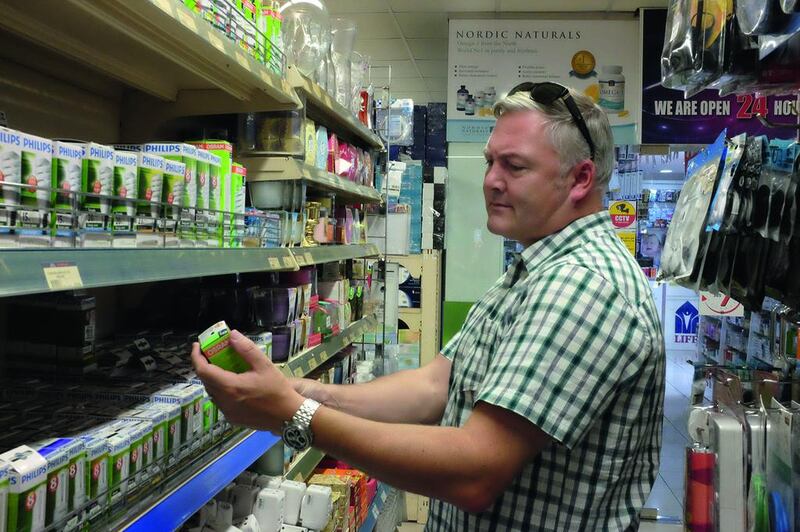It should be so simple: a light bulb reaches the end of its life in a literal flash, you go to the store and buy a replacement, remove the dud and replace it with the new one. Only, like so many things in life, it’s never that easy or straightforward, is it?
A quick scan around my apartment reveals that the “standard” bulb is no such thing. Large bayonet fitting, small bayonet. Large screw thread fitting, small screw thread. Golf-ball-shaped bulbs, candle-shaped bulbs, traditional-shaped bulbs. Halogen bulbs. Weird, quasi-fluorescent bulbs. My apartment is home to all these and more, making the task of replacing any of them something of a challenge. When the good old “normal” bulbs were freely available, they came in all sorts of instantly recognisable shapes, sizes and wattage ratings. Now, I haven’t the faintest idea what it is I’m looking at.
I do admit, however, that I’m a dinosaur and completely averse to change in any form. And the fact that this stretches to the kind of bulb that I fit in my lamps whenever the incumbents shuffle off this mortal coil shows just how far gone I am at times. Surely I’m not alone in this? Surely it’s not just me who gets wound up when men with clipboards dictate to me what I’m allowed or not allowed to use in my own home? Surely there must be an easier way of doing this? Surely?
Alas, it would appear not. As is the case in many Dubai apartments, not much thought was given in the design phase of the one that I live in when it comes to storage facilities for anything. Which means that I haven’t been able to stockpile contraband bulbs for the inevitable renewals. I have a minuscule “man drawer” in the kitchen and that’s it – no garage full of useful detritus for me. Oh no, I have to buy consumables such as these as and when they’re needed. Fortunately, when it comes to the bare necessities, there’s a 24-hour supermarket of impressive proportions on the ground floor of my building. It has an extensive selection of bulbs, so I pay the DIY-type section a visit to see what’s available in light of the UAE’s latest energy-saving initiative.
What I find is a 50/50 mix of new and old. On a shelf above the three-pin plug adapters, hammers, saws and other general DIY stuff is a bewildering array of bulbs. To the left are the old, now-verboten ones; to the right, the new, vividly packaged and much more expensive items. I need a set with small screw thread connections for the overhead light fixtures at home; the old, defunct ones were rated at 60 watts, so I scan the fancy boxes to find the environmentally acceptable replacements.
In the UK when I went shopping for these things, the wattage rating caused some confusion. Because they’re much more energy efficient, long-life bulbs require a lower current than conventional items. They never used to have an “equivalent rating” printed on the box, making it nothing more than guesswork to get the correct ones. Now I find the Philips “Genie” bulbs packaging has addressed the issue and an 11-watt new item is equivalent to a 60-watt oldie. It claims an energy efficiency rating of “A”, an eight-year lifespan (I can say from previous experience that this is wishful thinking) and each bulb is guaranteed for a year – a good thing, too, if you’re buying a load of them, as they would represent a fairly sizeable investment.
Fortunately, as the lights are uplighters and the bulbs are hidden from view, it doesn’t matter what shape the replacements are, so long as they fit within the confines of the shades. “Warm white” say the boxes, as if to alleviate any harsh-lighting anxiety, so I duly get on the stepladder for a session of “in with the good, out with the bad”.
After just a couple of minutes of fiddling and wiping dusty fingers on my trousers, the job is complete. I switch them on. As expected, they take a minute or so to “go nuclear” and achieve full brightness. When they do, I notice no difference whatsoever – which is known to us dinosaurs as “a very good thing”.
Weirdly, now that I’m compliant (at least with some of my lighting) and more planet-friendly, I start wondering about disposal of the old ones. Recycling in my building amounts to reusing carrier bags for dropping waste down a chute into a large skip somewhere stinky on the ground floor. So it’s obvious that, as a city, Dubai still has some way to go when it comes to limiting our effect on Planet Earth.
Baby steps and all that, but at least we’re moving in the right direction. It’s about time.





